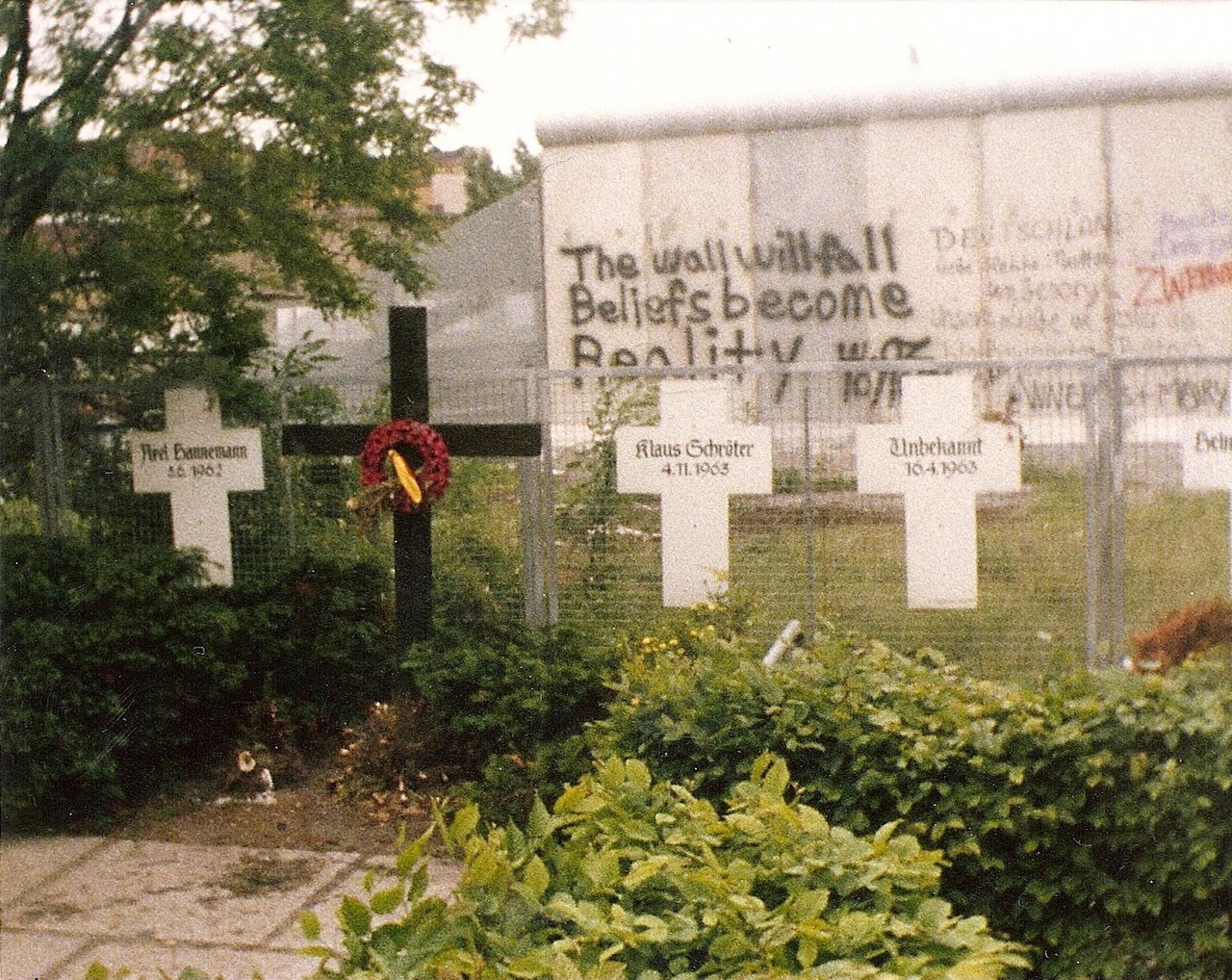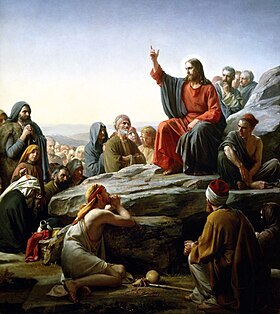
“Memorial to the Victims of the [Berlin] Wall, with graffiti, 1982….”
* * * *
 There’s been a lot of talk – lately and for the last two years – about Donald Trump’s wall. (The “colloquial name for a proposed expansion of the fence that makes up the Mexico–United States barrier during the presidency of Donald Trump.”) Which led me to wonder:
There’s been a lot of talk – lately and for the last two years – about Donald Trump’s wall. (The “colloquial name for a proposed expansion of the fence that makes up the Mexico–United States barrier during the presidency of Donald Trump.”) Which led me to wonder:
“Isn’t this like ‘deja vu all over again?'”
Which brings us to the Berlin Wall:
[The] guarded concrete barrier that physically and ideologically divided Berlin from 1961 to 1989… [S]tarting on 13 August 1961, the Wall cut off (by land) West Berlin from virtually all of surrounding East Germany and East Berlin… The barrier included guard towers placed along large concrete walls, accompanied by a wide area (later known as the “death strip”) … and other defenses. The Eastern Bloc portrayed the Wall as protecting its population from fascist elements conspiring to prevent the “will of the people” in building a socialist state…
East Germany also called the Wall its “Anti-Fascist Protection Rampart,” while the West Berlin city government referred to it as the “Wall of Shame.” Wikipedia also noted that the East German government took the action because of its “brain drain problem.”
In other words, people who wanted the promise of freedom were kept in virtual prison:
In the West, the Berlin Wall was regarded as a major symbol of communist oppression. About 5,000 East Germans managed to escape across the Berlin Wall to the West, but the frequency of successful escapes dwindled as the wall was increasingly fortified. Thousands of East Germans were captured during attempted crossings and 191 were killed.
(Berlin Wall built – HISTORY.) Which brings up the question: “Do we really want to be like East Germany? Do we really want to build a ‘major symbol of oppression?'”
 Ronald Reagan – for one – said no. He – like most if not all presidents before him – bought into the idea of America as a unique “city upon a hill.” That idea in turn is based on what Jesus said in Matthew 5:14, “You are the light of the world. You cannot hide a city that has been built upon a mountain.” (From His parable of Salt and Light in the Sermon on the Mount, seen at right.)
Ronald Reagan – for one – said no. He – like most if not all presidents before him – bought into the idea of America as a unique “city upon a hill.” That idea in turn is based on what Jesus said in Matthew 5:14, “You are the light of the world. You cannot hide a city that has been built upon a mountain.” (From His parable of Salt and Light in the Sermon on the Mount, seen at right.)
To give you some background on the American take on that idea: In 1630, the Puritan “father” John Winthrop cited Matthew 5:14 at the end of his lecture or treatise, “A Model of Christian Charity.” That sermon (lecture, or treatise) languished in obscurity for over 300 years. That is, until the beginning of the Cold War – which included the building of the Berlin Wall. That’s when “Cold War era historians and political leaders made it relevant to their time, crediting Winthrop’s text as the foundational document of the idea of American exceptionalism.” (Which included Thomas Jefferson’s seeing America as the world’s great “Empire of Liberty.”)
President-Elect John F. Kennedy quoted the phrase during an address in January 1961:
We are committing ourselves to tasks of statecraft no less awesome than that of governing the Massachusetts Bay Colony, beset as it was then by terror without and disorder within. History will not judge our endeavors—and a government cannot be selected—merely on the basis of color or creed or even party affiliation. Neither will competence and loyalty and stature, while essential to the utmost, suffice in times such as these. For of those to whom much is given, much is required.
(Which itself is from Luke 12:48.) In other words, America is special, and because it’s special, all Americans have unique and special responsibilities. For one thing, we have a special responsibility not to be “just like other countries.” We don’t want to build walls, either to keep freedom-seeking people out, or to keep smart people from leaving the country.
 Which is pretty much what Ronald Reagan said, over and over again. And this even though, politically, he was the exact opposite of John F. Kennedy. But they both agreed on the idea of the United States as a “city upon a hill.”
Which is pretty much what Ronald Reagan said, over and over again. And this even though, politically, he was the exact opposite of John F. Kennedy. But they both agreed on the idea of the United States as a “city upon a hill.”
For example, in his Election Eve address (November 3, 1980), Reagan spoke of his Vision for America: “I have quoted John Winthrop’s words more than once on the campaign trail.” Reagan added that Americans – at least in 1980 – were still “every bit as committed to that vision of a shining ‘city on a hill'” as the long-ago people who settled this country.
Finally – in that speech – he said Americans weren’t “white or black, red or yellow; they are not Jews or Christians; conservatives or liberals; or Democrats or Republicans. They are Americans awed by what has gone before, proud of what for them is still… a shining city on a hill.”
And Reagan repeated the theme yet again in his 1989 Farewell speech to the nation:
I’ve spoken of the shining city all my political life … a tall, proud city built on rocks stronger than oceans, wind-swept, God-blessed, and teeming with people of all kinds living in harmony and peace; a city with free ports that hummed with commerce and creativity. And if there had to be city walls, the walls had doors and the doors were open to anyone with the will and the heart to get here.
Which – in its way – mirrored just what Jesus said in John 6:37: “I will never turn away anyone who comes to me.” So whose side are you on? Hopefully, Jesus and Ronald Reagan…
* * * *

* * * *
The upper image is courtesy of Berlin Wall – Wikipedia.
The “farewell speech” link is to Opinion | Ronald Reagan’s Hopeful Farewell – The New York Times, by John Meacham. Dated January 10, 2019, the piece was sub-titled: “His last speech as president was about his faith in America and its people. Our current president could not be more different.”
The lower image is courtesy of Mr Gorbachev Tear Down This Wall – Image Results. See also Tear down this wall! – Wikipedia, which included this from the 1987 speech: “We welcome change and openness; for we believe that freedom and security go together, that the advance of human liberty can only strengthen the cause of world peace.”